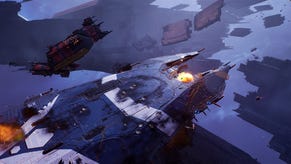Remembering Prey, Arkane Austin’s masterpiece
Un-mimicable
Confident design is one thing, but there is confidence, and then there’s the almost reckless certainty required in both your game’s sturdiness and the player’s curiosity to trust a feckless, glitch-hungry, poking-and-prodding player with Prey (2017)’s GLOO Cannon. Here is a first-person game set in a sprawling, multi-tiered, metroidvania-esque space station - one boasting multiple-bathroom verisimilitude - which then immediately gives the player a gun that lets them bypass the level gating by letting them make their own ladders up keycard-locked grav-elevators.
Prey is a game with an array of psychic powers stolen from eldritch aliens, in which I routinely ignored these abilities in favour of making sure I had enough foam darts for my toy crossbow, a tool whose unassuming utility translates to such power that it sits, in my mind, alongside something like Doom’s BFG. Prey is a game whose own BFG, its most powerful weapon, is a throwable mainly used for recycling office chairs into little cubes of matter. It’s a game that embodies what the essayist Campster called ‘0451’ design in such a way that, even though it does feature that code, you’ll never even have to use it. You’ll rarely have to use any keycode, because you can usually just possess a coffee cup and roll through tiny spaces. You will make inventory space for that coffee cup. Or pack of ramen. Or booze bottle. And you will never be without it. Shotgun shells don’t even come close.
These tools all have something in common: they allow for transgressions of space in a game where transgression is so often intended that it’s only noticeable as such when compared to other, duller, safer games. Dull, safe games do tend to sell, though. Maybe that’s why Arkane Austin were coaxed into making dreary live service Redfall, and maybe that’s why Arkane Austin don’t exist anymore. I’d be tempted to call Prey a middle finger to the sort of games Bethesda C-suite, and later Microsoft, probably would have preferred. From its inky mimics to its wider themes, Prey is a Rorschach test, and Rorschachs always did make people with guilty consciousness feel uncomfortable. But Prey always struck me as more concerned with generosity and boundless creativity and paying loving homage to seem like it gave much of a shit about what the rest of the industry was doing.
Prey, like Arkane’s Dishonored games, has some of the best Steam achievements you’ll ever see. Some of its more obscure and difficult ones offer up permissive inspiration to get real weird with it. To finish them is not just to tick off tasks or indulge in collect-athons, but to get to know Prey intimately, to reveal and delight in its possibilities and permutations. Kill no-one. Kill everyone. Play with no powers. Play with just Typhon powers, then again with just human powers. They were clearly made by someone who, too, knew and loved Prey intimately. But then again, just to know Prey is to love it intimately. Unless you're wrong, and that's OK too. Prey would want me to let you be wrong, because it wants such options to be available.
Prey’s story is perfect. Including, and especially, its ending. I will not hear a single complaint, blinded by an exhaustingly literal-minded, Wookiepedia-fied approach to art, that the events you take part in ‘don’t matter’ because of a later plot revelation. The ending is the perfect summation of its themes, ambitions, and game design. Prey’s defining piece of fictional technology is called Looking Glass. It was always a game about games, and the ending is an ending about players.
Prey: Mooncrash is, by all accounts, incredible. I haven’t played enough of it to say anything interesting about it. Sorry. John liked it.
I think I wanted to write a eulogy for a studio that made games which represent the potential of contemporary game design better than almost any other. At their best, Arkane Austin's games - such as Prey, but also those co-developed with Arkane Lyon - felt like AAA games from an alternate universe, one where it was decided that the medium’s advancement had nothing to do with with visual fidelity or whatever new tech Nvidia wants to convince us is necessary. A universe where all that money and tech and know-how went into making games wider, not sharper.
This isn’t that eulogy. It’s probably not even a love letter. Call it a Post-it note, stuck to a safe. A reminder, in case you needed it. The industry didn’t deserve Prey, but we got it anyway. Arkane Austin didn’t deserve to be closed, but it happened anyway. Thank you for the games. Thank you for the Gloo Cannon.










